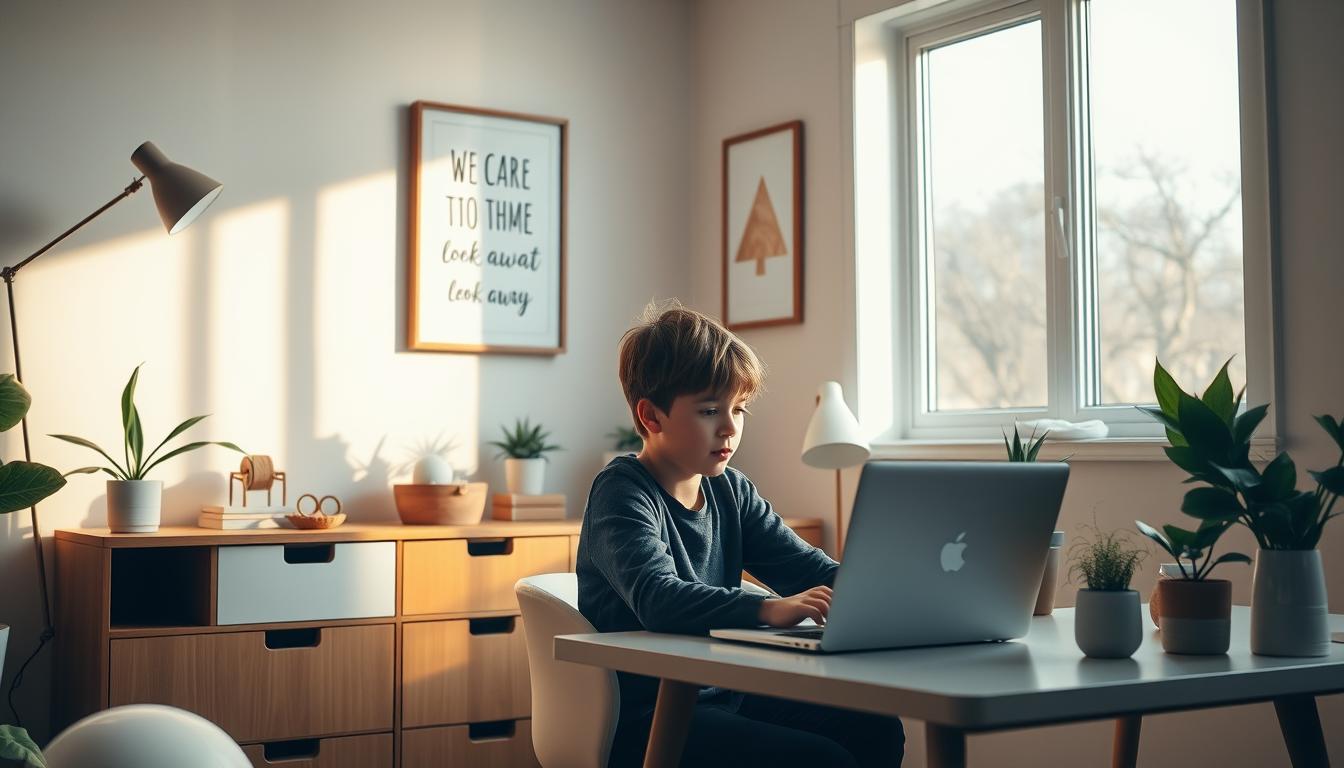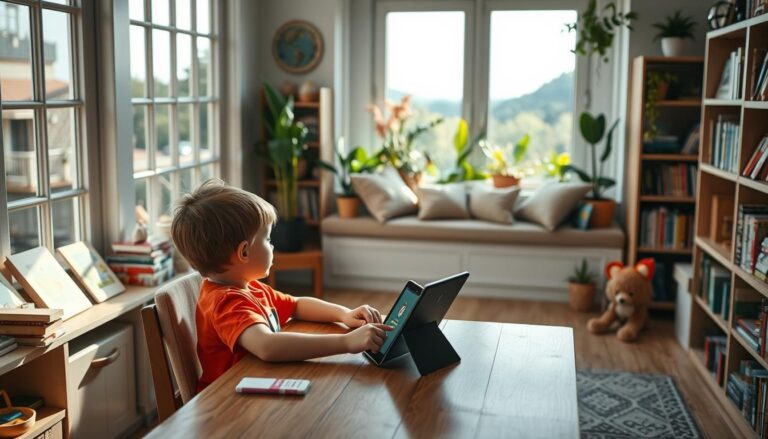Managing Screen Time for K-12 Online Students
Have you ever wondered how digital devices are shaping your child’s education and well-being? In today’s world, technology plays a vital role in learning, but it also brings challenges that parents and educators must address.
As digital tools become essential for education, finding the right balance is crucial. Too much exposure can affect a child’s focus and health, while too little might hinder their learning opportunities. This is where effective strategies come into play.
In this article, we explore practical ways to manage digital usage for K-12 students. From expert guidelines to actionable tips, we aim to help parents and educators create a healthy balance. Together, we can ensure that technology enhances learning without compromising well-being.
Understanding the Digital Shift in K-12 Learning
The rise of digital tools in education has transformed how children learn and interact. While technology offers new opportunities, it also brings challenges that affect health, focus, and social skills. This shift is particularly evident in the Indian context, where unique factors come into play.
Impact on Health, Focus, and Social Skills
Increased use of digital devices has led to concerns about children’s well-being. Research shows that prolonged exposure can strain vision, affect posture, and reduce concentration. Social skills may also suffer as face-to-face interactions decrease.
Parents play a crucial role in addressing these issues. Open communication between families and educators can help create a balanced approach to digital learning. Encouraging physical activities and offline interactions can mitigate some of these effects.
Unique Challenges in the Indian Virtual School Context
In India, the shift to digital learning has highlighted infrastructural and cultural challenges. Limited access to technology and reliable internet in rural areas creates disparities. Cultural norms around education also influence how families adapt to this change.
Family dynamics are deeply affected. Parents often mediate between traditional expectations and modern learning methods. Collaborative efforts between schools and families are essential to ensure children thrive in this new environment.
| Aspect | Benefits | Challenges |
|---|---|---|
| Health | Access to diverse learning resources | Eye strain, poor posture |
| Focus | Interactive and engaging content | Reduced attention span |
| Social Skills | Global connectivity | Less face-to-face interaction |
Exploring the Effects of Excessive Screen Time
Excessive use of digital devices can have lasting effects on a child’s well-being and development. While technology enhances learning, overexposure often leads to physical, mental, and academic challenges. Understanding these effects is the first step toward creating a healthier digital environment for young learners.
Physical and Mental Health Implications
Prolonged device usage can strain a child’s eyes and lead to poor posture. Studies show that extended exposure often results in headaches and reduced sleep quality. These physical issues can hinder daily activities and overall well-being.
Mental health is equally affected. Overuse of devices has been linked to increased anxiety and attention deficits. Children may struggle to focus on tasks, impacting their ability to learn effectively. Addressing these concerns requires a balanced approach.
Academic and Social Development Considerations
Excessive digital engagement can also affect academic performance. Children may find it harder to concentrate in class or complete assignments. This can lead to lower grades and reduced motivation to learn.
Social skills may suffer as well. Reduced face-to-face interactions can limit opportunities to build meaningful relationships. Encouraging offline activities and family time can help mitigate these effects.
Experts like the American Academy of Pediatrics recommend integrating physical activity into daily routines. Regular breaks from devices can improve focus and overall health. By fostering a balanced approach, we can ensure that technology supports rather than hinders a child’s growth.
Implementing “screen time limits virtual school” Effectively
Creating a balanced digital environment for children requires practical strategies and expert guidance. The American Academy of Pediatrics (AAP) offers valuable insights to help parents and educators manage device usage effectively. By following these recommendations, we can ensure that technology enhances learning without compromising well-being.
Guidelines from the American Academy of Pediatrics
The AAP emphasizes the importance of structured plans to regulate device usage. For children aged 6 and older, they recommend consistent daily limits and regular breaks. These breaks, ideally every 20 minutes, help reduce eye strain and improve focus.
Parents are encouraged to create a Family Media Plan. This plan outlines specific rules for device use, ensuring that children have time for physical activities and offline interactions. By involving the whole family, we can foster healthier digital habits.
Setting Up Screen-Free Zones and Timers
Designating screen-free zones in the home is another effective strategy. Areas like dining rooms and bedrooms should remain device-free to encourage face-to-face communication and better sleep hygiene.
Using timers during virtual classes can also help. Setting reminders for short breaks allows children to stretch, rest their eyes, and recharge. These small adjustments can make a big difference in their overall well-being.
| Strategy | Benefit | Implementation |
|---|---|---|
| Family Media Plan | Structured rules for device use | Involve the whole family |
| Screen-Free Zones | Encourages offline interaction | Designate specific areas |
| Timers and Breaks | Reduces eye strain and improves focus | Set reminders every 20 minutes |
By adopting these strategies, we can create a healthier digital environment for children. Leading by example and using practical tools can make this transition smoother for everyone involved.
Practical Strategies for Parents and Educators
Balancing technology use with offline activities can enhance a child’s learning and creativity. Parents and educators play a key role in fostering a healthy digital environment. By setting clear rules and encouraging alternative activities, we can help children develop essential skills.
Establishing Clear Rules and Digital Boundaries
Creating a structured plan is the first step. Families should agree on specific rules for device use. For example, tech-free times during meals or evenings can encourage offline interactions. This approach helps children understand the importance of balance.
Communication is vital in reducing conflicts. Parents and educators should discuss expectations openly. By involving children in the process, we can ensure they feel heard and respected. This collaborative effort fosters a sense of responsibility.
Encouraging Offline Activities
Offline activities like reading, crafting, or outdoor play promote creativity and skill development. These activities provide a break from devices and help children explore new interests. Parents can lead by example by participating in these activities together.
Collaborative planning between parents and teachers ensures consistency. Schools can support families by sharing resources and strategies. This partnership creates a unified approach to managing digital engagement.
| Strategy | Benefit | Implementation |
|---|---|---|
| Tech-Free Times | Encourages offline interaction | During meals or evenings |
| Family Media Plan | Structured rules for device use | Involve the whole family |
| Offline Activities | Promotes creativity and skills | Reading, crafting, outdoor play |
By adopting these strategies, we can create a healthier digital environment for children. Leading by example and using practical tools can make this transition smoother for everyone involved.
Enhancing Learning Through Balanced, Offline Activities
Balancing online and offline activities can significantly boost a child’s learning and creativity. While technology plays a vital role in education, hands-on tasks and physical engagement are equally important. These activities not only enhance academic performance but also promote overall well-being.
Integrating Activity-Based Learning into Daily Routines
Activity-based learning helps children grasp concepts more effectively. Simple tasks like reading a book, crafting, or outdoor play can make learning enjoyable. These activities stimulate creativity and improve focus, making them a valuable addition to daily schedules.
Physical exercise is another key component. Activities like cycling, yoga, or even a walk in the park can improve health and energy levels. Combining these with academic tasks ensures a well-rounded approach to development.
Creating a Collaborative Family Media Plan
A Family Media Plan is an excellent tool to manage technology use. It designates specific times for online learning and offline recreation. This plan encourages open communication and ensures everyone in the family is on the same page.
Offline activities like board games or storytelling sessions can strengthen family bonds. These moments provide a break from devices and foster meaningful interactions. By working together, families can create a balanced and supportive environment for children.
Incorporating offline activities into daily routines is essential for holistic development. By blending technology with hands-on tasks, we can ensure children thrive both academically and personally.
Conclusion
Finding the right balance between digital tools and offline activities is essential for a child’s growth. Excessive device usage can impact health, focus, and social skills, making it crucial to adopt expert guidelines and consistent routines. By combining regulated usage with creative offline activities, families can foster healthier interactions and stronger bonds.
We encourage parents and educators to implement these strategies to create a supportive environment. Small changes, like designated breaks and screen-free zones, can make a big difference. Together, we can ensure that technology enhances learning without compromising well-being.
For more insights on fostering a balanced approach to online education, explore our resources. Let’s work together to empower children to thrive in both digital and offline worlds.







